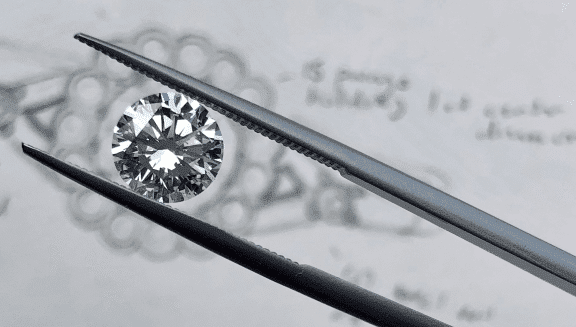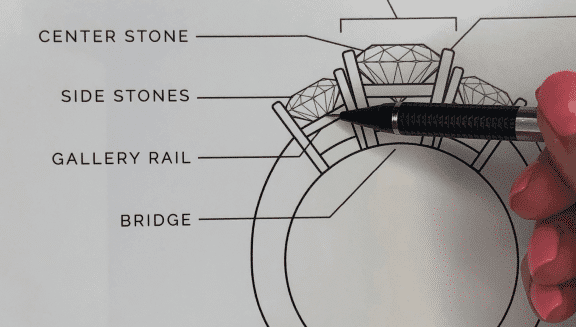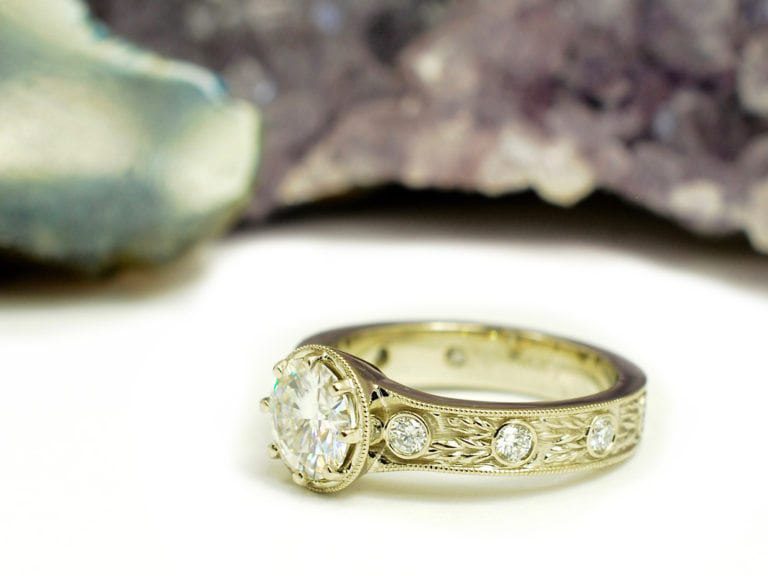Lab-Grown Diamonds: A Great Diamond Engagement Ring Alternative
“There is very little to no ecological footprint in making lab-grown diamonds. No legal or ethical issues, no ground pollution, no conflicts, and this product is renewable!” – Claudia Endler
When you think engagement rings you’re probably thinking diamonds, consciously or subconsciously. Diamonds are loved by many due to their stunning brilliance, high durability, and rarity. Though these stones dominate industry sales, more and more consumers are becoming wary of the unethical practices and high price tags that come with mined diamonds. So what do you do if you’re set on a diamond for your engagement ring but you’re concerned about the earth and sustainability in general with a tight budget? Might we suggest creating a custom engagement ring using lab-grown diamonds. These stunning stones ARE diamonds, however they are ethical and cost significantly less than mined ones. Get all the facts about lab-grown diamonds and see why we think they are a wonderful diamond engagement ring alternative.

(14k white gold, 1 carat lab-grown diamond center stone custom engagement ring made exclusively by Abby Sparks Jewelry, The Ginny styled shot)
Lab-grown diamonds are diamonds that were created in a laboratory. Also known as engineered or cultured diamonds, these stones are produced using advanced technology rather than sourced naturally from the earth.
Lab-Grown Diamond History
It all began in 1879 with Scottish chemist James Ballantyne Hannay, who first attempted to create diamonds by using a carbon crucible and flame-heated tube to heat charcoal and iron to extremely high temperatures. Though many others strived to create diamonds using a variety of methods, it was only in 1941 when General Electric (GE) and other companies banded together did we see further development of diamond synthesis using carbon. In 1954, Tracy Hall, a GE physical chemist, achieved the first commercially successful synthesis of a diamond.
For over a century, man has been experimenting with technology to grow diamonds. Many stones made by GE were used for industrial tools. It wasn’t until 1971 that GE was able to create gem-quality diamonds in a laboratory. The first stones were yellow and brown in color due to a high contamination of nitrogen. In 2012, Gemesis Diamond Company announced a breakthrough method to create a colorless diamonds in a lab. These colorless stones, like mined diamonds, are becoming very popular for lab-grown diamond custom engagement rings.
How are Lab-Grown Diamonds Made?
Lab-grown diamonds are made in highly controlled labs using one of two methods. Some companies use the first and oldest method, the High-Pressure High-Temperature technique. Advanced technology mimics high pressure and temperature conditions of a natural diamond to form crystals. Another popular method is called Chemical Vapor Deposition (CVD). By taking carbon rich vapor from carbon atoms and placing them in a chamber, the stone’s crystal structure begins to form and build upon itself. The process of growing a lab-grown diamond takes about 3 months to complete, which is nothing compared to waiting thousands of years for a natural diamond to form under Earth’s crust. It’s astounding that in just 90 days you can have a gemstone that is equal to a natural diamond for a lab-grown diamond engagement ring.
Diamonds vs. Lab-Grown Diamonds
Are lab-grown diamonds really diamonds? The answer is yes. Lab-grown diamonds are diamonds, they just happen to be made by people in a laboratory rather than mined from the earth. Due to their man-made origins, they are often referred to as “synthetic diamonds” or “diamond simulants”, though we at Abby Sparks Jewelry know these terms do not accurately depict a lab-grown diamond’s true nature. A “synthetic” or “simulant” is a term used for a stone with the same look as a diamond but not the same properties. Lab-grown diamonds are not imitations, but rather they have the same chemical composition, and crystal properties. They are identical to diamonds, the only difference being they are made in a laboratory.
(Sparkle video of a one carat round, diamond in the Abby Sparks Jewelry showroom)
Lab-Grown Diamond Characteristics
The 4 C’s
Like diamonds, lab-grown diamonds are graded based on four main characteristics: color, carat, cut, and clarity. Their value is based on a combination of these characteristics. Lab-grown diamonds come in many colors from pink to green but by far the most popular is colorless.
Lab-grown diamonds are also valued on their carat weight. With all else being equal, the higher the carat weight, the higher the cost of the stone. Clarity and cut also contribute to value. Carat, clarity and cut also affect the brilliance and fire of lab-grown diamonds. Like mined diamonds, they have a refractive index of 2.417 meaning your lab-grown diamond engagement ring will not lose its sparkle. Don’t believe us? Check out our lab-grown custom engagement rings.
Durability
“A diamond is forever” and lab-grown diamonds are not excluded. With the same chemical and crystal structure as mined diamonds, lab-grown diamonds are one of the hardest known substances. The connections between their carbon atoms are extremely tough, giving natural and lab-grown diamonds a hardness of 10 on the Mohs Scale of Hardness. Lab-grown diamonds are a great option for some of our active or accident prone clients due to their resistance to chipping, breaking, and scratching unless by another diamond. During our Custom Design Process, we ensure that your stone matches your lifestyle so your jewelry can last a lifetime.
Inclusions
Though the process to create lab-grown diamonds resembles the environmental conditions of mined diamond formation, it cannot be identical. One of the major distinctions between lab-grown diamonds and mined diamonds are their imperfections. All diamonds have microscopic imperfections within their structure. These flaws in crystal structure are beautiful imperfections that give a diamond its personality. A naturally occurring diamond may contain different inclusions than a lab-grown diamond because it had a world of unknown variables affecting its creation while the lab-grown diamond was made in a controlled space. The difference is miniscule. Inclusions cannot be seen with the naked eye, making lab-grown diamonds very difficult to distinguish from mined diamonds. As a part of our Custom Design Process our clients get the unique opportunity to experience these inclusions first hand. We source stones that are the best fit for our client’s needs and let them choose the ones they want in their custom jewelry. (14k white gold, 1 carat lab-grown diamond center stone custom engagement ring made exclusively by Abby Sparks Jewelry, The Ginny)
(14k white gold, 1 carat lab-grown diamond center stone custom engagement ring made exclusively by Abby Sparks Jewelry, The Ginny)
Why Choose Lab-Grown Diamonds?
Price
“The man always wants to buy the best quality for his money, and the woman always wants to buy the larger diamond within the budget. So if they go with a lab grown diamond, they both win.” – Gerald David Bauman
One of the main reasons why lab-grown diamonds are attractive is that they are more budget-friendly than their mined counterparts! A one-carat lab-grown diamond is typically priced 15-20% less than a mined diamond, making lab-grown a great option for those who want more for their money when it comes to their engagement ring.
Ethics
The fear of indirectly supporting conflict by purchasing blood-diamonds is one that is becoming more common. We are now informed consumers! Consumers are now empowered to be more curious about the origin of their stone. The Kimberley Process is a system of regulations that be used as a resource to weed out unethical diamond practices, but as with all systems there is room for error. Lab-grown diamonds are a great option for those who want the diamond with none of the conflict. Because these stones were made in a lab rather than mined from the earth, they produce no ethical consequences. Consumers can find out where their stone was made and be assured knowing their diamond is 100% conflict free.
Takeaway
Lab-grown diamonds are growing in popularity for engagement rings, and we’re not surprised. Not only do consumers get real diamonds, but these stones are also budget-friendly and conflict-free! You can get more of what you want while being sure that your stone is good for you and the environment.
Check out some of our lab-grown custom engagement rings, like the Ginny shown above, for inspiration on your own custom engagement ring! Still set on natural diamonds? We can do that for you! See examples of our work on our Custom Engagement Ring page. If you’re ready to start creating your one-of-a-kind, custom engagement ring, call us at 303.957.6502 or contact us online to book an initial consultation at our showroom in the Lower Highlands of Denver, CO. Not in Denver? No worries! Our Custom Design Process works just as well over the phone or over video chat. We promise to help you through every step and create the custom engagement ring of your dreams.







Comments